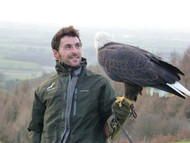Understanding The Scope Of Senses
Posted by Understanding the scope of senses, Parrots using their sight, how to understand your Parrot’s senses on 1/4/2025
Mike Simmons tells us how to understand your Parrot?s senses.
On returning from a trip to the North York Moors with my feathered companion Bald Eagle Georgia, it made me realise how privileged I am to be part of this bird?s world. Forming such a relationship requires so much understanding in order to create a unique and special bond.

As a professional bird and mammal trainer my job is to understand the needs of the animals I work with. This not only requires experience in reading the individual?s expressed behaviours but also to know the science and operating system of that species.
Ponies
Most of the animals I?m in the company of are avian, which is the term used for different species of bird. Although my work sometimes involves some mammals ranging from Shetland ponies to clouded leopards.
Some of the world?s best animal trainers state that birds are one of the most difficult to train of all wildlife. Birds usually oppose the aids you could use to control other animals, such as the lead you walk a dog with or the reins to control a horse.
Second, to having little aided control over a bird, when working freely with them they have a vertical exploratory zone as well as a horizontal one.
With all this said it?s paramount to understand how the particular bird being interacted with or taught will naturally operate. It?s important to have knowledge on how the animal sees, moves, hears and smells.
The primary sense of a Bald Eagle like Georgia and of most diurnal birds is their sense of vision. It?s said that an eagle can see the movement of an ant from a perch sited ten stories above the ground.
Stadium
They could read the expression on a footballers face from the worst seats in the biggest of stadiums.
Their vision often allows them to see into the ultraviolet spectrum allowing them to see a vast amount of colour compared with the human eye. To sum up their vision, it?s simply extraordinary and superior to my own or any human for that matter.
The reason for my trip to the North York Moors was to primarily allow this majestic soaring eagle the chance to fly on the uplift created by the hills and valleys.
Second to the physical exercise and stimulation of flying is the enrichment factor of allowing a huge expanse of sky to be studied by her binocular vision. In fact Georgia has regular trips to forests, open fields and even the coasts. This is for no other reason than to let her use her natural sight and see different landscapes.
There is a sense of contentment when she does so and I believe all birds love to watch the world go by. After studying many species of wild birds, it?s apparent that once their daily intake of food has been satisfied they will roost in safety and comfort and study their environment.
Eagle
My trip benefitted my bird?s wellbeing, but my own planning meant my time spent with the eagle over two days was positive to the both of us.
In my opinion all animals do well with small increments of training as broken down sessions, so if you are thinking of expanding your companion birds horizon then it?s important to start small and progress.
The expression ?chuck them into the deep end? doesn?t work well with birds.
If you are thinking of expanding your bird?s visionary enrichment by planning a few car journeys to viewpoints like Georgia trips out, then make time to think ahead. Ensure the bird is happy and safe in some form of carrier or crate and allow them time to settle at home in this first.
Another aspect to remember is your bird?s feeding regime. We give our birds only a small light breakfast before crating to travel, some snacks during transport and a favourite treat at the viewpoint or destination.
Food
If you can make a new experience have some association with a favourite food, the bird will remember this accompanying positive reinforcement that coincided with this new stimulating environment and will really enjoy the combined experience.
Birds will fly thousands of miles and change their country of origin on migration to have better seasonal foods, so little details like varied treats are a big deal and most appreciated by your feathered companion. Most of all the linking of positive stimulus yields great results in desensitising the animals to these potentially scary situations.
Planning is key to success which leads to positive experiences that create a harmonious relationship built from understanding. That?s the foundation principle which leads on to magical trips like the one I shared with my majestic eagle.
Get more information on training and behaviour here.

